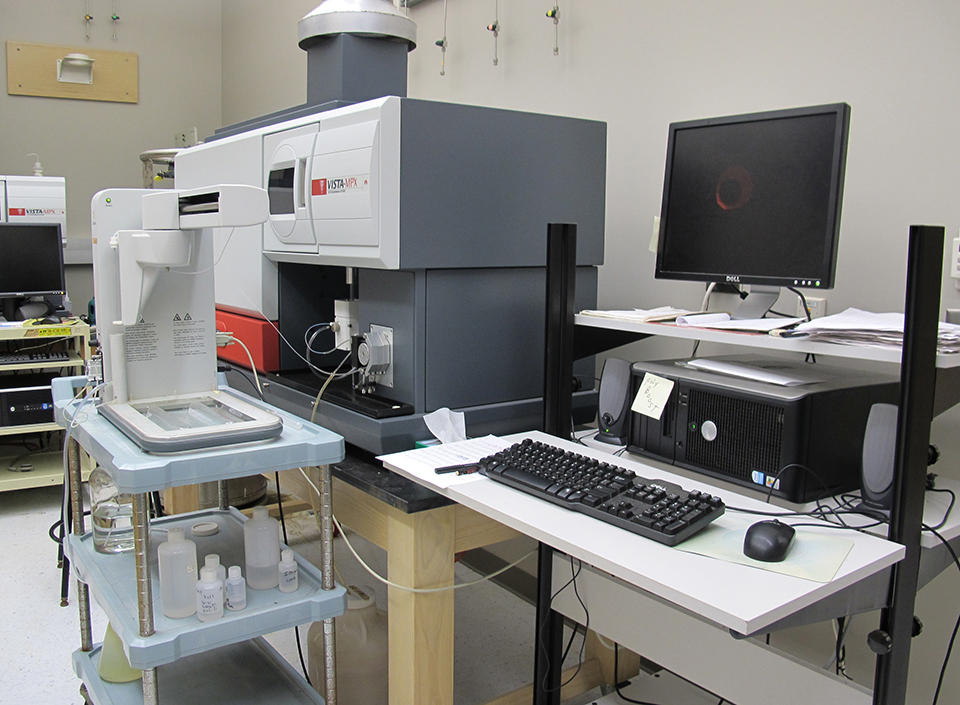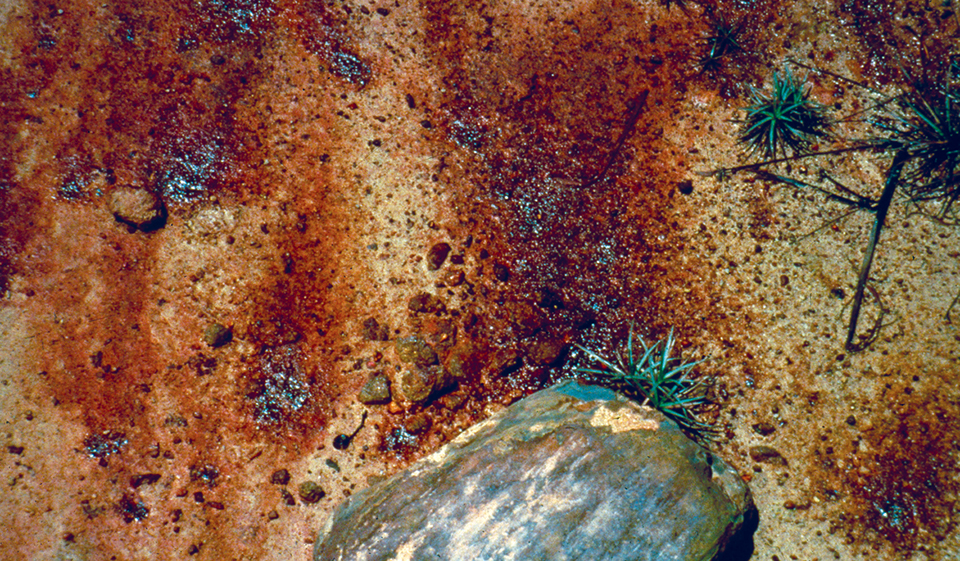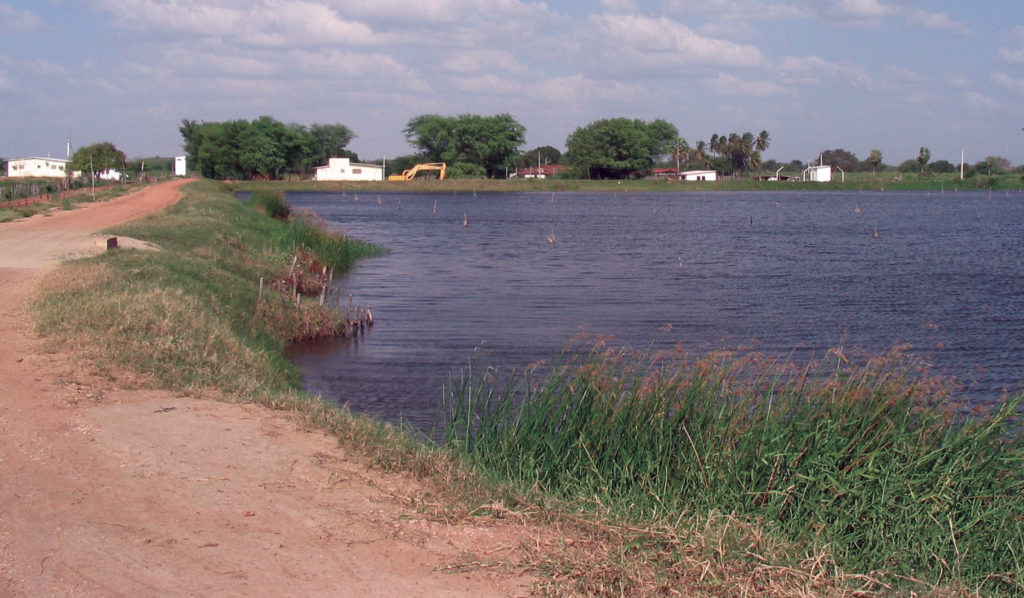Cross-check for reliability of ion analyses

The ionic composition of inland well water can vary from suitable to toxic to cultured animals. Reliable data on concentrations of major cations (calcium, magnesium, potassium, and sodium) and major anions (bicarbonate, sulfate, and chloride) is therefore important in the management of waters for inland shrimp farming.
Cation concentrations usually are determined by atomic absorption spectroscopy (AA method) or inductively coupled plasma emission spectroscopy (ICP method). Bicarbonate concentration can be calculated from total alkalinity concentration, which is determined by titration with standard acid. Sulfate concentration can be determined by the barium chloride turbidity method, and chloride can be measured by titration with standard mercuric nitrate.
In AA and ICP analyses of saline waters, dissolved salts can cause significant interference, so it is always a good idea to check analyses for reliability.
Anion-cation balance
One useful method for determining the reliability of major ion analyses of freshwater or saline water is measurement of anion-cation balance. This method assumes that major ions comprise most of the total dissolved solids in a water sample, and requires that all major ion concentrations are measured.
The principle of electrical neutrality requires that the equivalent weight of positively charged ions (cations) equal that of the negatively charged ions (anions). Because major ions usually represent most of the dissolved ions in water, equivalent amounts of major cations and anions are typically found. In an accurate analysis, the sum of the milliequivalents of major cations and anions should be nearly equal.
Milliequivalents
The milliequivalent of an ion is determined by dividing its concentration in mg/l by its milliequivalent weight in mg/milliequivalent. Milliequivalent weights for major ions are listed in Table 1.
Boyd, Milliequivalent weights of major ions. Table 1
| Anions | Anions | Cations | Cations |
|---|---|---|---|
| Bicarbonate | 61 mg/meq | Calcium | 20.04 mg/meq |
| Sulfate | 48 mg/meq | Magnesium | 12.16 mg/meq |
| Chloride | 35.45 mg/meq | Potassium | 39.1 mg/meq |
| Sodium | 23 mg/meq |
Balance calculation
The anion-cation balance calculation can be illustrated with data on the average concentrations of ions in water from a saline aquifer in Alabama, USA as follows: calcium, 86 mg/l; magnesium, 21 mg/l; potassium, 7.7 mg/l; sodium, 1,392 mg/l; sulfate, 2.0 mg/l; chloride, 2,274 mg/l; total alkalinity, 105 mg/l.
First, convert total alkalinity to bicarbonate by the following equation:

The balance calculations are shown in Table 2. Close agreement between the milliequivalents of anions and cations indicates the concentrations of major ions in the sample were analyzed accurately.
Boyd, Anion-cation balance example, Table 2
| Anions | Anions |
|---|---|
| Bicarbonate: 128 mg/l ÷ 61 meq/mg = 2.10 meq/l | Calcium: 250 mg/ ÷ 20.04 mg/meq = 12.48 meq/l |
| Sulfate: 2.0 mg/l ÷ 48 meq/mg = 0.04 meq/l | Magnesium: 22 mg/l ÷ 12.16 mg/meq = 1.81 meq/l |
| Chloride: 2,274 mg/l ÷ 35.45 meq/mg = 64.15 meq/l | Potassium: 14 mg/l ÷ 39.1 mg/meq = 0.36 meq/l |
| Sodium: 820 mg/l ÷ 23 mg/meq = 35.65 meq/l | |
| Total = 46.24 meq/l | Total = 50.30 meq/l |
Another example
Consider another example from a recently published paper on inland shrimp farming. The concentrations of major ions were reported as follows: calcium, 250 mg/l; magnesium, 22 mg/l; potassium, 14 mg/l; sodium, 820 mg/l; bicarbonate, 248 mg/l; sulfate, 690 mg/l; chloride, 985 mg/l. The anion-cation balance calculation (Table 3) reveals a greater difference between total anions and total cations than the first example. The average difference in milliequivalents of anions and cations can be estimated as follows:

If the average difference exceeds 15 percent, one should have serious reservations about the accuracy of the analysis.
Boyd, Anion-cation balance example, Table 3
| Anions | Anions |
|---|---|
| Bicarbonate: 248 mg/l ÷ 61 meq/mg = 4.07 meq/l | Calcium: 250 mg/ ÷ 20.04 mg/meq = 12.48 meq/l |
| Sulfate: 690 mg/l ÷ 48 meq/mg = 14.38 meq/l | Magnesium: 22 mg/l ÷ 12.16 mg/meq = 1.81 meq/l |
| Chloride: 985 mg/l ÷ 35.45 meq/mg = 27.79 meq/l | Potassium: 14 mg/l ÷ 39.1 mg/meq = 0.36 meq/l |
| Sodium: 820 mg/l ÷ 23 mg/meq = 35.65 meq/l | |
| Total = 46.24 meq/l | Total = 50.30 meq/l |
Checking accuracy
Another way of checking the accuracy of ion analyses is to determine if the sum of major ions is roughly equal to total dissolved solids. This procedure is suitable in freshwater or waters with 1 to 2 ppt salinity. However, at greater salinities, water of hydration is retained by the salt residue resulting from evaporation of the sample for total dissolved solids analysis. This leads to erroneously high values for total dissolved solids in saline water samples.
Conclusion
Reliable data on major cation and anion concentrations in waters is an important consideration for inland shrimp farming. The anion-cation balance method presented here to determine the reliability of major ion analyses of fresh- or saline water assumes that major ions comprise most of the total dissolved solids in a water sample, and requires that all major ion concentrations be measured.
(Editor’s Note: This article was originally published in the April 2002 print edition of the Global Aquaculture Advocate.)
Now that you've reached the end of the article ...
… please consider supporting GSA’s mission to advance responsible seafood practices through education, advocacy and third-party assurances. The Advocate aims to document the evolution of responsible seafood practices and share the expansive knowledge of our vast network of contributors.
By becoming a Global Seafood Alliance member, you’re ensuring that all of the pre-competitive work we do through member benefits, resources and events can continue. Individual membership costs just $50 a year.
Not a GSA member? Join us.
Author
-

Claude E. Boyd, Ph.D.
Professor, Department of Fisheries and Allied Aquacultures
International Center for Aquaculture and Aquatic Environments
Auburn University
Auburn, AL 36849 USA[117,100,101,46,110,114,117,98,117,97,64,49,101,99,100,121,111,98]
Tagged With
Related Posts

Responsibility
Accuracy of custom water analyses varies
The reliability of trace element analyses reported by custom laboratories cannot be checked by simple techniques, and results may not always be accurate. One should check the reliability of major ion analyses by determining the charge balance and comparing the measured total ion concentration with the total ion concentration estimated from conductivity.

Responsibility
Iron important to pond water, bottom quality
Iron supplementation of pond fertilizers can improve their effectiveness in promoting phytoplankton growth. Ferrous iron in bottom sediment precipitates hydrogen sulfide gas produced by microbial activity.

Responsibility
Water composition: Dissolved inorganic solids
A few anions and cations, and un-dissociated silicic acid represent the largest fraction of dissolved inorganic solids in water. The total concentration of ions is called the salinity. The total dissolved-solids concentration usually is roughly equal to salinity in freshwater. Unlike seawater, freshwater varies greatly in salinity and proportions of individual ions. Calcium and bicarbonate are dominant ions in river water, but sodium and chloride are dominant in seawater. Water contains many other inorganic substances, as well as many trace elements.

Responsibility
Salinity balance key to culture success
Outside optimal salinity ranges, aquaculture species have higher feed-conversion ratios, grow at slower rates, become stressed and susceptible to disease, or even die.


